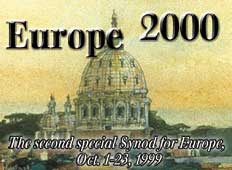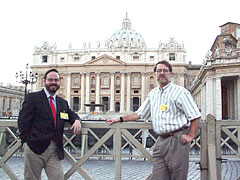

 |
 |
|
|
Who is to be the next pope and how will he be elected? By THOMAS C. FOX
As the European bishops gather in Rome for the second special synod on Europe in less than a decade, they are driven by two undeniable stark realities. One, the Roman Catholic Church is poised to enter a new century fraught with bold challenges. Two, it is being led by a man, by nearly all counts, coming to the end of his pontificate. On everyone’s mind: Who will be the first 21st century pope?” 
Not too far off looms a church conclave, that gathering of cardinals who will elect Pope John Paul II’s successor. The politics of succession are both subtle and fierce. The Oct. 1st to 23rd Synod for Europe provides both a stage for promotion and a caucus for discrete consideration. In this environment every appointment and every synod speech sends a potential signal to the wider church. Thus church observers here this week were quick to find deeper meaning in the selection by Pope John Paul of Cardinal Antonio Maria Rouco Varela, archbishop of Madrid, as synod general relator. No other position has more impact on synod deliberations. The pope, one long time church observer noted, is letting it be known who he wants to succeed him. An honored Catholic truth has it, however: “He who goes into a conclave a papabile comes out a cardinal. ” But how will the selection process work? What are the politics? What theories of selection hold water today? During this synod, John Allen and I will examine the street and corridor talk of Rome in search for the next pontiff. We will listen and share our observations on this page and in the newsweekly. Knowing that many synod participants stay wired to the Internet we also invite reflections. An archbishop said recently to me: “This is a time for careful consideration and preparation.” In the days ahead send your conclave considerations to me at TCFOX@aol.com or to John Allen at JLA12065@aol.com and we will find ways to share them with you on this web page. If anonymity is required, let us know. What follows is one selection theory held by some church watchers. It might be called the transition option. Here is how the theory works – and how it could possibly lead, initial appearances to the contrary, to the election of a pope who could bring substantial change to the church. Were the cardinal-electors to gather today 107 would be eligible to elect the next pope. In 1978, 111 elected the man who took the name John Paul II. History shows that relatively short ones often follow long pontificates. After many years of one pope the cardinal-electors seem to seek a period in which to re-group. Father Richard McBrien, who has written extensively about popes, also likes to say a pontificate often contrasts that of its predecessor. Rather than looking for an extension of the past, cardinals generally search for something new, the reasoning holds. If these two currents play out at the next conclave, the next man to wear papal white will be elected as a transitional or interim pope and he could be a man already in his seventies. Why the “safe” choice? Perhaps because we are crossing into a new era, not only a new century but also an entirely new millennium and church bishops, while overwhelmingly conservative, are by no means unanimous on where the church should go. Further there is great division in Roman Catholicism, coming out of a century in which the two dominant ecclesial forces have been the renewal of Vatican II and the counter-renewal of the John Paul II pontificate. Karl Wojtyla's election at John Paul II has often been referred to as the surprise” choice. Wojtyla was not on any short list before he emerged after a puff of white smoke from the Sistine Chapel in 1978 as the first non-Italian in 455 years, the first ever Slav to sit on St. Peter's throne and the youngest holder of the office in 130 years. John Paul II will leave his prominent mark on the church. That is clear. It may be the cardinals are not ready yet for another such heavy hand – however much conservatives in their ranks want to hold on to power. The “safe choice” or “transitional” theory holds the cardinals are not likely to be looking for another surprise. Thus, the theory has it, do not expect an African, or a Latin American, or an Asian, or a North American. Don’t expect another Eastern European -- that moment has passed for now. The “safe choice” theory calls for a return to comfortable surroundings. The “safe choice” theory leads forward by going backward. It leads to the election of another Italian pope, a pope to take the church into the 21st century, but not necessarily determine the church’s course in the century. That will be left to pope on the other end of the transition period.The next pope, the “interim” or “safe choice” theory holds, will come from a list of Italians already in their seventies. If so, the list of papabile, or papal contenders, comes from a list of about ten men with five or so, some relative unknowns, possessing what might be considered significant leadership qualities. Conservatives have, by wide margin, the votes to choose the next pope. So on the surface it appears unlikely the most internationally acclaimed Italian cardinal, the open-minded, 72-year-old Jesuit Archbishop of Milan, Carlo Maria Martini, will be considered seriously. Curiously, however, while few church observers in Rome today don’t see a “progressive” pope in the wings, many cardinals might be ready to elect a man who would offer a vision of renewed episcopal collegiality. There appears to be a consensus among many in the church hierarchy that local archbishops have been stripped of rightful authority by a heavy-handed Roman curia. Resentment abounds. For the same reason do not expect the next pope to emerge out of the Roman Curia. While undeniably powerful and certain to play critical roles in the decision process, curial members do not have the votes alone to elect one from their own ranks. Left on the list are four possible papal contenders. Giacomo Biffi, 71, Giovanni Saldarini, 74, Silvano Piovanelli, 75, and Marco Cé, 74. Biffi, archbishop of Bologna, is the most conservative of the lot. He is a member of the Congregation for the Doctrine of Faith and it is said he opposes the use of Mozart music at Mass, allegedly because the artist was a Mason. Maybe too conservative. Saldarini, archbishop of Turin, has distinguished himself for his devotion to the shroud; not well known enough. This leaves two men, both known for their pastoral abilities. Piovanelli, archbishop of Florence, spent years as a parish priest. That could help him. Cé, the Patriarch of Venice, has been a seminary director, has taught dogmatic theology and was the church’s chief advisor to Catholic Action. He followed Albino Luciani of Venice when Luciani was elected Pope John Paul I. Luciani was not the only pope this century to emerge from Venice. Pius X was patriarch of Venice when he was elected in 1903 and Angelo Roncalli, of Venice, became Pope John XXIII, a reminder that a pastoral-minded Italian could very well turn the church on its head. National Catholic Reporter, October 4, 1999 |